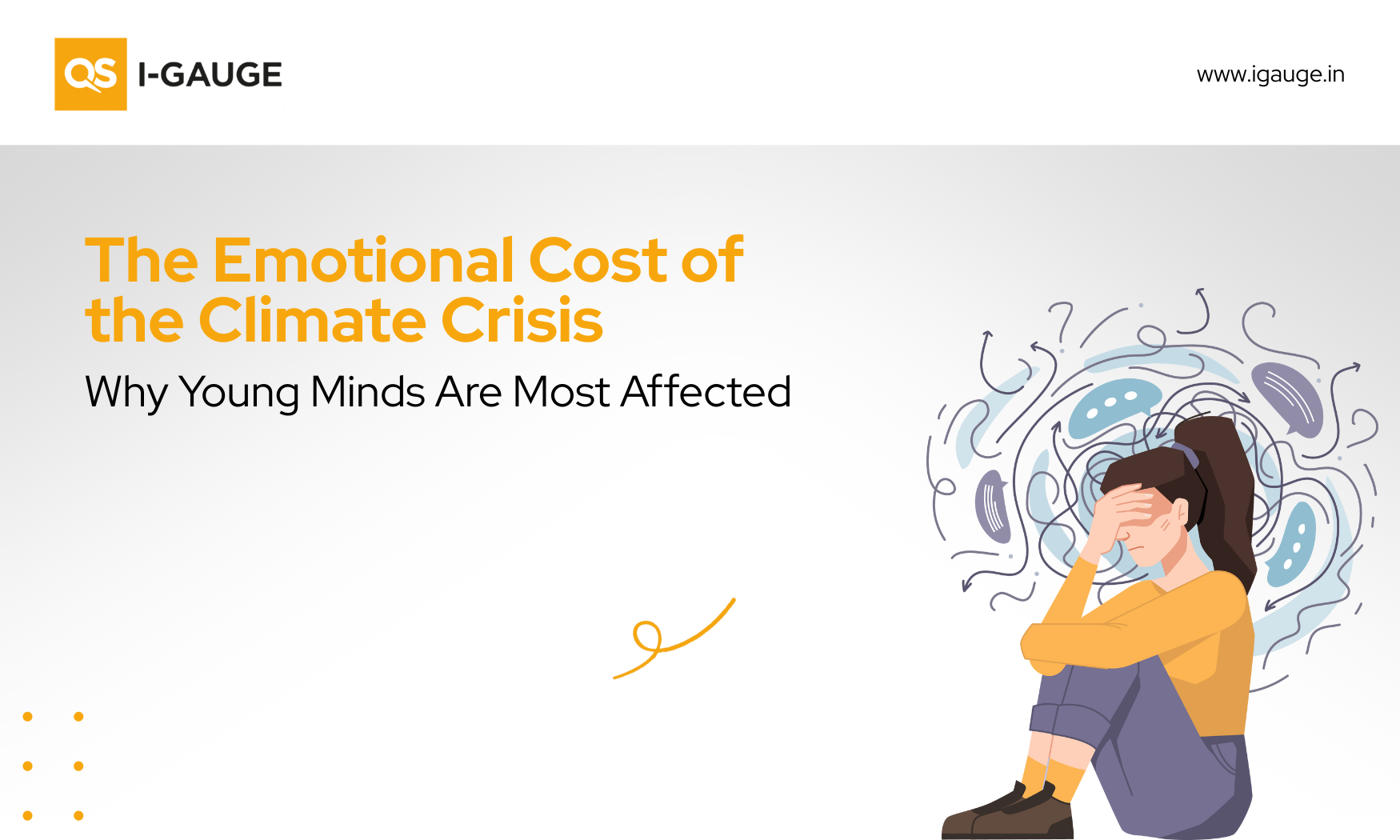.png)
Written by Dr Himanshu Pawar, Market Research Analyst, QS I-GAUGE
Back in the day, a new neologism was invented in Germany and added to Langenscheidt, the German youth dictionary. Little did the world know that the portmanteau ‘Smombie’ would aptly reflect the gormless attitude of individuals connected with the world but disconnected from reality. The expression is a combination of the words ‘smartphone’ and ‘zombie’ that mocks the unwavering dedication of lone individuals towards technology. Consumed in a frenzy of tickers and oblivious to their surroundings, they march towards a slow loss of cognitive functions of the human brain.
More than a decade has passed since the term was coined, and the potential risks have not waned the peculiarity surrounding human behaviour. Due to the increasing importance of technology in our daily lives, it is unlikely to fade away; instead, an upsurge is expected in unprecedented ways that will challenge society. Not denying the fact that sincere efforts have been made to tackle this problem, it continues to haunt the pedestrians and by-passers in metro cities. Scientific literature already informs us that there are negative effects on an individual's gait when using smartphones [1]. Young children and adults engaged in dual-tasking are more prone to accidents. While using smartphones, an individual's gait tends to a shortened stride and step lengths, and the span of surrounding awareness diminishes substantially [2]. Walking is considered an involuntary task and is effortless when it comes to using cognitive functions of the brain; however, distractions, sensory overload, and information overload can cause brain fatigue and are highly likely to interfere with basic functions and everyday tasks.
According to the latest report on road accidents in India by the ‘Ministry of Road Transport and Highways’, 19 deaths occur every hour in the country due to various road mishaps and reasons. The report states that in 2022, there were 7,558 accidents and 3,395 deaths due to the use of mobile phones while driving [3]. Still, there is a paucity of research into accidents, particularly related to the segment of people using mobile phones while walking or crossing roads.
Pedestrians share part of the responsibility for their safety and security, and most people are well-updated with generic guidelines such as (obeying traffic signals, crossing streets at designated areas, using sidewalks, watching for cars turning or backing up, etc.). Still, local administration and city councils are responsible for providing a safe environment for all pedestrians to walk and crossroads. There are countless manuals, signage and advertisements to apprise pedestrians of rules, regulations and their responsibilities. However, the extent to which they are enforced, respected and followed is debatable and varies from one country to another.
Trending on X
One such initiative by the Bengaluru City Traffic Police (BCTP) was advertised in a public space where pedestrians were more prone to road accidents. One of the X (formerly Twitter) users captured the signboard image and whimsically shared it on the social media platform. Little did the user know it blew up and trended on the platform, garnering more than 400k+ views.
The comments included reactions from all genders and age groups towards the progressive approach of the city traffic police in dealing with smombies. Quite candidly, the views of the youth and teenagers in the comments depicted the acknowledgement of the problem of smartphone addiction, but most of them seemed to ward it off with cheeky comments and contemporary jargon.
One of the users wrote, “Fact, not an attack. The same is required to be placed at all busy junctions." Another one wrote, "Insignboard image traffic. They can’t wait for 30-60 seconds without using mobile phones”. Such comments flooded the social media platform, and it was evident that there was complete awareness among all age groups concerning the harmful effects of smartphone overuse, but the majority of them seemed to be in a state of denial and oblivion.
The reasons for such behaviour are well documented in scientific literature, such as the tendency to get stuck in a dopamine reward loop that brings pleasure to the mood and body or the release of cortisol (stress hormone) due to the almost helpless need to check and re-check notifications on the smartphone. Other factors include social anxiety, isolation, and validation by peers, which have gripped youngsters and adults into a perpetual loop of addiction.
Academic Research into Smombies
Since the word was introduced in the dictionary, and given the exponential rise of smartphone usage and its intrusive effects on our personal and professional lives, ample research has been conducted worldwide into the phenomenon.
The studies are primarily conducted around the addictive effects of smartphones and the scathing urge to [not let go] whilst being purposefully ignorant of its harmful effects on the physiological, cognitive and emotional aspects of human personality. However, research into the concept of smombies is limited and restricted to a few countries and particular settings of time and place only. It can be divided into multiple sub-heads, such as the ramifications of human behaviour, smartphone addiction, and the prevention of accidents.
In a recent research conducted in Spain [4] it was found that considering gender almost half of the young women are found to be engaged in smombie behaviour across all age groups. A further study conducted in Paris in 2018 [5] found more females (33.3%) as ‘phone walkers’ when compared to males (19.7%). However, some other studies have shown that smartphone addiction is more prevalent in males than in females [6,7]. The results are inconsistent since it is a matter of time, place, accessibility and societal maturity.
It was also found that individuals can only exhibit a limited load on cognitive capacity while walking. If we overstress or burden it with more external stimuli, the walking behaviour moves from a more automated level to a conscious one. Decreased attention, reduced peripheral vision, loss of physical integrity, and activation of embodied habits using smartphones are significant behavioural risks associated with being a smombie.
Since the reduction in the number of accidental cases of using smartphones while walking is not foreseeable anytime soon, researchers worldwide and technology companies are focusing more on remedial measures. For example, Walk-safe, CrashAlert and SpareEye are some research-based applications based on enhanced camera solutions using machine learning algorithms and object detection [8,9,10]. Quite interestingly, the concept of having a shoe-mounted sensor is proposed in one of the recent research works that profiles the floor gradients and alerts the user of the change from one-floor surface to another. Globally, local governments and municipal corporations have decided to save smombies in their own indigenous ways. Seoul, the capital city of South Korea, has dedicated warning signs for people walking with smartphones at large intersections. A dedicated sidewalk has been created in Antwerp city in Belgium that separates the smombies from regular pedestrians [11]. These initiatives might seem to carry utopian practicality and feasibility for the majority of the places in the world, but nevertheless, efforts are being made to increase pedestrian safety and security.
Smartphone addiction at Schools, Colleges and Universities
Smartphone addiction gives rise to ‘nomophobia’ (fear of losing a mobile phone), a rising behavioural disorder engulfing the youth of the current generation. Press articles, government health advisories, and academic literature are replete with the adverse physical and mental health effects of smartphone abuse at schools, colleges and universities.
The majority of schools do not allow mobile devices to be carried inside the premises, but the strict enforcement of such directives is a grey area. Students often indulge in clandestine activities with mobile and electronic devices in high school. Using them as tools for cheating or as an exhibition of personality cults or status symbols is increasing in modern schooling. The early childhood years, which are also the formative years of development, are supplemented by smartphone and tablet usage, both at school and at home. Thus, it has become a necessity for parents to provide their kids with access to such devices due to the hyper-competitive nature of modern schooling.
Features such as age lock and content filters do, to an extent, help to reduce screen time and accessibility, but research states that the ‘habit’ needs a break. The lax attitude of parents and schools and the social pressure to own a smartphone device are leading the current generation (GenAlpha) into a more stressful, anxiety-prone, and impatient nurturing environment.
Multiple studies have found evidence of smartphone addiction among youth in colleges and universities. [12,13]. Varying levels of addiction are prevalent depending upon the socioeconomic, cultural and childhood grooming status of children. The excessive use of smartphones by students at universities and colleges is found to negatively impact academic performance and psychological elements of personality such as compulsive behaviour, withdrawal, anxiety, etc. In context-specific studies, the influence of excessive usage was found to lead children towards exhibiting a lack of attention, lack of self-control, hyperactivity and anger. Students in colleges and universities are becoming prone to ‘academic procrastination’, which is a voluntary delay of action on academic tasks despite knowing the consequences. According to a report [14] on smartphone usage by university students, it was found that students check their notifications and messages on average at least 150 times per day. Plausible reasons include anxiety, loneliness, and FOMO (fear of missing out). It was also found that 63% of the students use smartphones for more than 4 hours a day, and 23% use them for more than 7 hours a day.
With mobile phones and electronic devices so profoundly embedded in our daily lives, it is challenging to control their abuse. No doubt, it is essential to stay informed about the evolving world, and the constant urge to remain connected with peers cannot be overstated; technologies will continue to progress, and so will our reliance on them, but it is also crucial to be cognizant of their potential ill effects.
References
[1] Kim, D., Han, K., Sim, J. S., & Noh, Y. (2018). Smombie Guardian: We watch for potential obstacles while you are walking and conducting smartphone activities. PLoS one, 13(6), e0197050.
[2] Fernández, C., Vicente, M. A., Carrillo, I., Guilabert, M., & Mira, J. J. (2020). Factors influencing the smartphone usage behavior of pedestrians: Observational study on “Spanish smombies”. Journal of medical Internet research, 22(8), e19350.
[3] Ministry of Road Transport and Highways. (2023). (rep.). Road Accidents in India 2022. Delhi.
[4] Schaposnik LP, Unwin J. The phone walkers: a study of human dependence on inactive mobile devices. Behav 2018;155(5):389-414.
[5] Schaposnik LP, Unwin J. The phone walkers: a study of human dependence on inactive mobile devices. Behaviour 2018;155(5):389-414.
[6] Lee E.J., Kim H.S. Gender differences in smartphone addiction behaviors associated with parent–child bonding, parent–child communication, and parental mediation among Korean elementary school students. J. Addict. Nurs. 2018;29:244–254.
[7] Aljomaa S.S., Qudah M.F.A., Albursan I.S., Bakhiet S.F., Abduljabbar A.S. Smartphone addiction among university students in the light of some variables. Comput. Hum. Behav. 2016;61:155–164. doi: 10.1016/j.chb.2016.03.041.
[8] T. Wang, G. Cardone, A. Corradi, L. Torresani, and A. T. Campbell, ‘‘WalkSafe: A pedestrian safety app for mobile phone users who walk and talk while crossing roads,’’ in Proc. 12th Workshop Mobile Comput. Syst. Appl., 2012, pp. 1–7.
[9] J. D. Hincapé-Ramos, and P. Irani, ‘‘CrashAlert: Enhancing peripheral alertness for eyes-busy mobile interaction while walking,’’ in Proc. SIGCHI Conf. Hum. Factors Comput. Syst., 2014, pp. 3385–3388.
[10] K. T. Foerster, A. Gross, N. Hail, J. Uitto, and R. Wattenhofer, ‘‘Spareeye: Enhancing the safety of inattentionally blind smartphone users,’’ in Proc. 13th Int. Conf. Mobile Ubiquitous Multimedia, 2014, pp. 68–72.
[11] Martinez, C. (2022, July 5). Smombies: The New Safety Challenge for cities in the 21st Century. Inclusive City Maker. https://www.inclusivecitymaker.com/smombies-new-safety-challenge-cities/
[12] AlBarashdi H.S. Smartphone Usage, Gratifications and Addiction among Sultan Qaboos University Undergraduates: A Mixed-Approach Investigation. Sultan Qaboos University; Muscat, Oman: 2015. unpublished.
[13] Buctot D.B., Kim N., Kim J.J. Factors associated with smartphone addiction prevalence and its predictive capacity for health-related quality of life among Filipino adolescents. Child. Youth Serv. Rev. 2020;110:104758. doi: 10.1016/j.childyouth.2020.104758.
[14] Smartphone addiction: University Students in India check their smartphones up to 150 times a day. Firstpost. (2018, April 23). https://www.firstpost.com/tech/news-analysis/smartphone-addiction-university-students-in-india-check-their-smartphones-up-to-150-times-a-day-4442283.html



